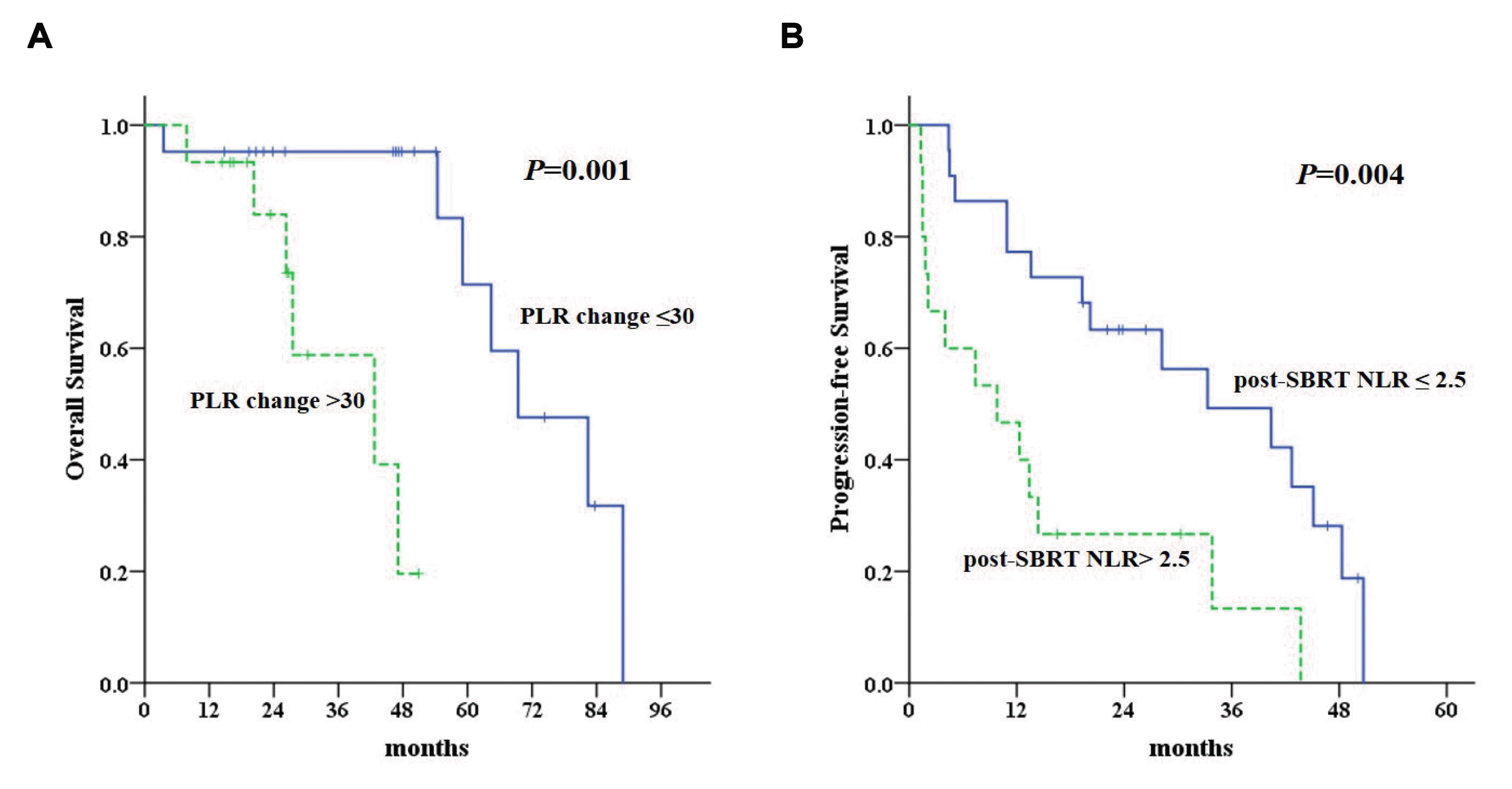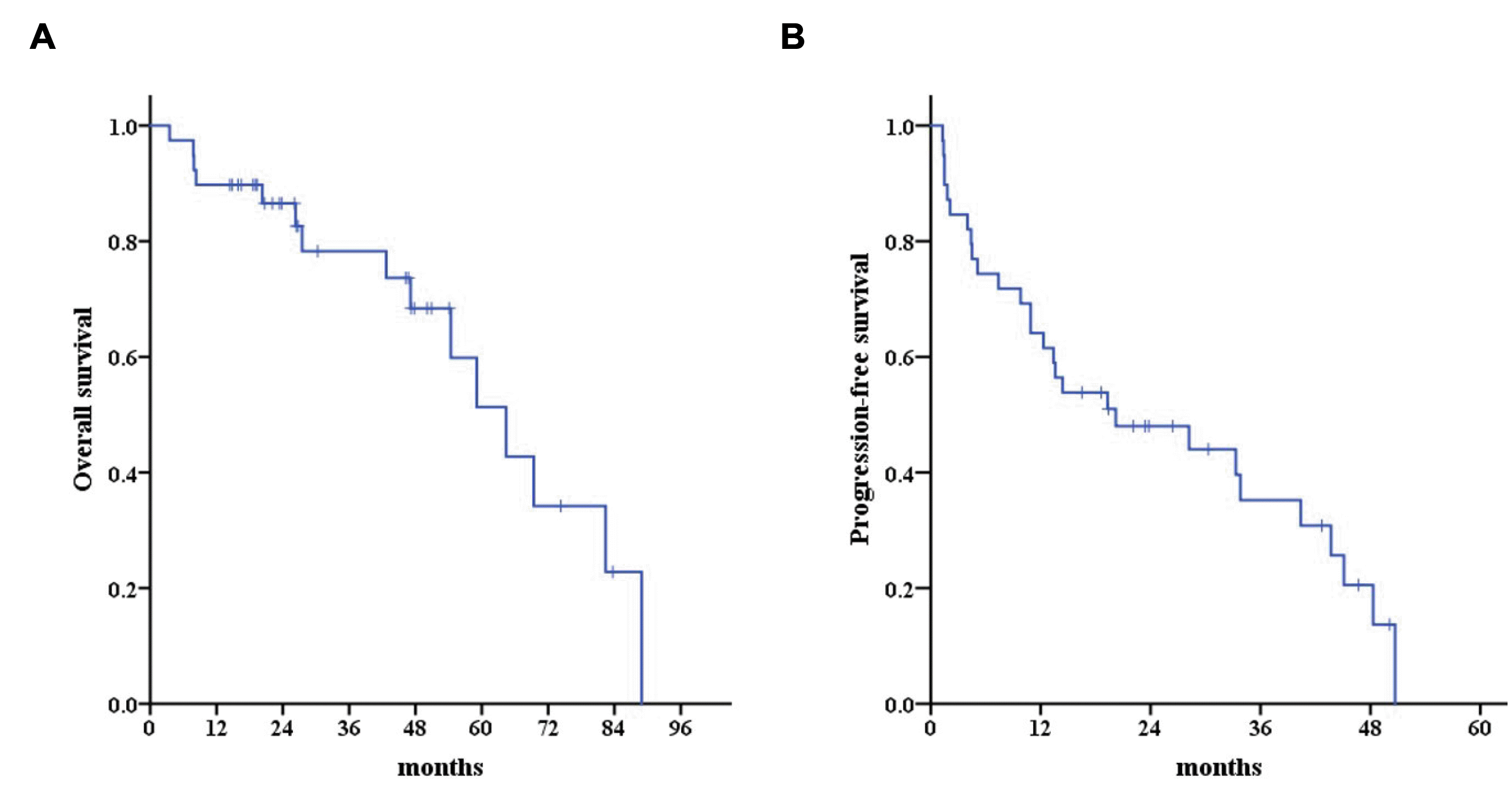2. Culleton S, Jiang H, Haddad CR, et al. 2014; Outcomes following definitive stereotactic body radiotherapy for patients with Child-Pugh B or C hepatocellular carcinoma. Radiother Oncol. 111:412–417. DOI:
10.1016/j.radonc.2014.05.002. PMID:
24906626.

3. Scorsetti M, Comito T, Cozzi L, et al. 2015; The challenge of inoperable hepatocellular carcinoma (HCC): results of a single-institutional experience on stereotactic body radiation therapy (SBRT). J Cancer Res Clin Oncol. 141:1301–1309. DOI:
10.1007/s00432-015-1929-y. PMID:
25644863.

4. Koh HK, Park Y, Koo T, et al. 2021; Neutrophil-to-lymphocyte ratio after definitive concurrent chemoradiotherapy predicts survival in patients with esophageal squamous cell carcinoma. In Vivo. 35:1133–1139. DOI:
10.21873/invivo.12359. PMID:
33622911. PMCID:
PMC8045095.

5. Yoshida K, Yoshikawa N, Shirakawa A, et al. 2019; Prognostic value of neutrophil-to-lymphocyte ratio in early-stage ovarian clear-cell carcinoma. J Gynecol Oncol. 30:e85. DOI:
10.3802/jgo.2019.30.e85. PMID:
31576683. PMCID:
PMC6779610.

6. Diem S, Schmid S, Krapf M, et al. 2017; Neutrophil-to-lymphocyte ratio (NLR) and platelet-to-lymphocyte ratio (PLR) as prognostic markers in patients with non-small cell lung cancer (NSCLC) treated with nivolumab. Lung Cancer. 111:176–181. DOI:
10.1016/j.lungcan.2017.07.024. PMID:
28838390.

7. Lee BM, Chung SY, Chang JS, Lee KJ, Seong J. 2018; The neutrophil-lymphocyte ratio and platelet-lymphocyte ratio are prognostic factors in patients with locally advanced pancreatic cancer treated with chemoradiotherapy. Gut Liver. 12:342–352. DOI:
10.5009/gnl17216. PMID:
29409306. PMCID:
PMC5945266.

8. Lee JH, Song C, Kang SB, Lee HS, Lee KW, Kim JS. 2018; Predicting pathological complete regression with haematological markers during neoadjuvant chemoradiotherapy for locally advanced rectal cancer. Anticancer Res. 38:6905–6910. DOI:
10.21873/anticanres.13067. PMID:
30504408.

9. Proctor MJ, Morrison DS, Talwar D, et al. 2011; A comparison of inflammation-based prognostic scores in patients with cancer. A Glasgow Inflammation Outcome Study. Eur J Cancer. 47:2633–2641. DOI:
10.1016/j.ejca.2011.03.028. PMID:
21724383.

10. Zheng J, Cai J, Li H, et al. 2017; Neutrophil to lymphocyte ratio and platelet to lymphocyte ratio as prognostic predictors for hepatocellular carcinoma patients with various treatments: a meta-analysis and systematic review. Cell Physiol Biochem. 44:967–981. DOI:
10.1159/000485396. PMID:
29179180.

11. Kinoshita A, Onoda H, Imai N, et al. 2012; Comparison of the prognostic value of inflammation-based prognostic scores in patients with hepatocellular carcinoma. Br J Cancer. 107:988–993. DOI:
10.1038/bjc.2012.354. PMID:
22878374. PMCID:
PMC3464773.

12. Jang WI, Bae SH, Kim MS, et al. 2020; A phase 2 multicenter study of stereotactic body radiotherapy for hepatocellular carcinoma: safety and efficacy. Cancer. 126:363–372. DOI:
10.1002/cncr.32502. PMID:
31747476.

14. Mantovani A, Allavena P, Sica A, Balkwill F. 2008; Cancer-related inflammation. Nature. 454:436–444. DOI:
10.1038/nature07205. PMID:
18650914.

16. Popp I, Grosu AL, Niedermann G, Duda DG. 2016; Immune modulation by hypofractionated stereotactic radiation therapy: therapeutic implications. Radiother Oncol. 120:185–194. DOI:
10.1016/j.radonc.2016.07.013. PMID:
27495145.

17. Tajiri K, Baba H, Kawai K, et al. 2016; Neutrophil-to-lymphocyte ratio predicts recurrence after radiofrequency ablation in hepatitis B virus infection. J Gastroenterol Hepatol. 31:1291–1299. DOI:
10.1111/jgh.13287. PMID:
26729319.

18. Chew V, Lee YH, Pan L, et al. 2019; Immune activation underlies a sustained clinical response to Yttrium-90 radioembolisation in hepatocellular carcinoma. Gut. 68:335–346. DOI:
10.1136/gutjnl-2017-315485. PMID:
29440463. PMCID:
PMC6352403.

19. Rutkowski J, Ślebioda T, Kmieć Z, Zaucha R. 2017; Changes in systemic immune response after stereotactic ablative radiotherapy. Preliminary results of a prospective study in patients with early lung cancer. Pol Arch Intern Med. 127:245–253. DOI:
10.20452/pamw.3997. PMID:
28420863.
21. Okamura Y, Sugiura T, Ito T, et al. 2016; Neutrophil to lymphocyte ratio as an indicator of the malignant behaviour of hepatocellular carcinoma. Br J Surg. 103:891–898. DOI:
10.1002/bjs.10123. PMID:
27005995.

22. Zhou D, Liang J, Xu LI, et al. 2016; Derived neutrophil to lymphocyte ratio predicts prognosis for patients with HBV-associated hepatocellular carcinoma following transarterial chemoembolization. Oncol Lett. 11:2987–2994. DOI:
10.3892/ol.2016.4359. PMID:
27123051. PMCID:
PMC4840749.

23. Chen K, Zhan MX, Hu BS, et al. 2018; Combination of the neutrophil to lymphocyte ratio and the platelet to lymphocyte ratio as a useful predictor for recurrence following radiofrequency ablation of hepatocellular carcinoma. Oncol Lett. 15:315–323. DOI:
10.3892/ol.2017.7291. PMID:
29285194. PMCID:
PMC5738684.

24. Tian XC, Liu XL, Zeng FR, Chen Z, Wu DH. 2016; Platelet-to-lymphocyte ratio acts as an independent risk factor for patients with hepatitis B virus-related hepatocellular carcinoma who received transarterial chemoembolization. Eur Rev Med Pharmacol Sci. 20:2302–2309. PMID:
27338055.
25. Zhuang Y, Yuan BY, Hu Y, et al. 2019; Pre/post-treatment dynamic of inflammatory markers has prognostic value in patients with small hepatocellular carcinoma managed by stereotactic body radiation therapy. Cancer Manag Res. 11:10929–10937. DOI:
10.2147/CMAR.S231901. PMID:
32099457. PMCID:
PMC6997220.
26. Peng W, Li C, Wen TF, et al. 2014; Neutrophil to lymphocyte ratio changes predict small hepatocellular carcinoma survival. J Surg Res. 192:402–408. DOI:
10.1016/j.jss.2014.05.078. PMID:
24998425.

27. Dan J, Zhang Y, Peng Z, et al. 2013; Postoperative neutrophil-to-lymphocyte ratio change predicts survival of patients with small hepatocellular carcinoma undergoing radiofrequency ablation. PLoS One. 8:e58184. DOI:
10.1371/journal.pone.0058184. PMID:
23516447. PMCID:
PMC3597630.

28. Dharmapuri S, Özbek U, Lin JY, et al. 2020; Predictive value of neutrophil to lymphocyte ratio and platelet to lymphocyte ratio in advanced hepatocellular carcinoma patients treated with anti-PD-1 therapy. Cancer Med. 9:4962–4970. DOI:
10.1002/cam4.3135. PMID:
32419290. PMCID:
PMC7367631.

29. Ma W, Zhang P, Qi J, et al. 2016; Prognostic value of platelet to lymphocyte ratio in hepatocellular carcinoma: a meta-analysis. Sci Rep. 6:35378. DOI:
10.1038/srep35378. PMID:
27739490. PMCID:
PMC5064312.

30. Xiao WK, Chen D, Li SQ, Fu SJ, Peng BG, Liang LJ. 2014; Prognostic significance of neutrophil-lymphocyte ratio in hepatocellular carcinoma: a meta-analysis. BMC Cancer. 14:117. DOI:
10.1186/1471-2407-14-117. PMID:
24559042. PMCID:
PMC4015698.






 PDF
PDF Citation
Citation Print
Print





 XML Download
XML Download